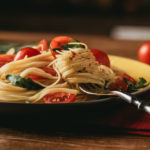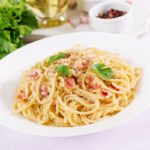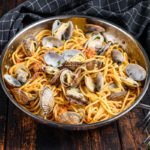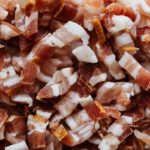Whether you’re coeliac, gluten intolerant, avoiding wheat, or simply find regular pasta to sit a little too heavy in your stomach, there’s never really been a like-for-like gluten free alternative to pasta.
All too often you cook it up only to be left with a disintegrating mush at the bottom of your saucepan which has a weird after taste when you eat it.
After repeated disappointments, you find yourself asking: gluten free pasta – is it worth it?
With that in mind, we’re giving Barilla’s range of gluten free pasta the taste test. Read on to discover our thoughts on this certified gluten free pasta.
Why not try our Weeknight Dinners: Prawn Pasta Recipe with some of the gluten free pasta mentioned in this article.
Reviewing Barilla’s Gluten Free Pasta
Points to note:
Barilla’s GF range of pasta has been certified gluten free, and, according to Nielsen, is the number one gluten free pasta brand in the US.
The pasta is produced on dedicated gluten-free production line and made with Non-GMO ingredients.
Can’t find Barilla Gluten Free Pasta in your local shops? Don’t worry. You can buy it, along with a whole range of other gluten free products, right here.
Ingredients:
Barilla’s gluten free pasta includes: corn flour, rice flour, mono and diglycerides.
What? Monoglycerides? Yep. I know. I was 100% with you there…initially.
You can google it, but you’ll end up with an assortment of viewpoints. You’ll find some bloggers freaking out over it, Wikipedia giving you a general understanding, and some ‘health’ sites warning you of these “bad” ingredients.
But let’s think about this logically for a moment….mono means one, di means two.
Glycerides are esters made up of fatty acids and glycerol molecules. One glycerol molecule attached to a fatty acid, or one glycerol attached to two fatty acids.
The most common types of fat are triglycerides, but these are broken down naturally by enzymes to diglycerides and monoglycerides.
Mono and diglycerides are used in manufacturing as emulsifiers. Something that binds certain ingredients together that don’t usually bind too well. Like oil and water.
But where do these mono- and diglycerides actually come from? They are extracted mostly from plants, or animal products, or they can be synthetically made.
Typically by breaking down triglycerides into the mono and diglyceride forms, just like the enzyme gastric lipase does in our stomach to some of the fat we consume.
Should you be concerned? In short, no. If you’re enjoying some gluten free pasta in the appropriate serving size, as part of a healthy, colourful, and fresh-produce heavy diet, then no.
A little bit of an emulsifier to keep your occasional pasta flours together is highly unlikely to do your health any harm.
Plus, you get to enjoy your old favourites again, and not have it fall apart into mush when you cook it!
Wondering what to make for dinner tonight? Check out our Gluten-Free Dinner Ideas
Nutrition Profile of Barilla Gluten Free Pasta
Per 100g, you’ll find on the penne packs (Barilla also sells elbows and spaghetti in Australia)
- 7g protein,
- 2g fat,
- 79g carbs,
- 0g sugar,
- 0g sodium.
Per 56g serve, you’re looking at roughly 200 calories (840kJ), so I like to halve the serve and bulk up the dish with vegetables, especially if I’ve had a less-than-active day.
Tasting Barilla Gluten Free Pasta
The taste is just like regular pasta – no funny aftertaste. In fact, minimal flavour at all, ready to soak up all that delicious sauce you add to it.
Barilla also make gluten free pasta sauces to go with their pasta range. I’ve tried the Napoletana and the Bolognese sauce and they’re delish!
Do you love a mid-morning snack? Try our Gluten-Free Almond Chia Scone Recipes
Purchasing
You can buy it from Coles or Woolworths around Australia and other major grocery stores globally. At the time of writing, the price is $3.79 AUD per box.
Fancy a sweet treat? Our Grain-Free Paleo Chocolate Chia Seed Cake Recipes might interest you.
The Positives
The pasta cooks very well, and is so easy to make. No wonder pasta is a staple for uni students and busy families – it’s practically fool-proof. But gluten free pasta was never that easy until now. In the past, far too many gluten-free pastas have turned to a soggy mass before their cooking time is up.
The improvements they’ve made in their product formulation really outshine other pasta brands I’ve tried in the past.
You can find some that are a little more wholesome, but I’ve never had any success with them holding up to the cooking process, or matching the taste, texture and refrigerated shelf-life of the Barilla range.
The Negatives
Honestly, like 95% of all pasta, they’re made from refined ingredients, which are best kept to a smaller percentage of your total diet.
However, when cravings hit, or you’re pressed for time, you can easily jazz up your pasta dish with a tonne of vegetables, and satisfying protein to get a nutritious meal in no time.
Plus, it helps fill the tummies of active people, or fussy mouths who want something “normal” to eat, without containing a long list of ingredients or anything known to be harmful to our health long term.
For more on the importance of eating a range of foods, see Achieving Food Variety (Whilst Remaining Gluten-Free)
The Ratings
Based upon the above and used as an inclusion to a wholesome, plant-based, colourful diet, I give the Barilla gluten free pasta range:
- Nutrition – 5/10 (purely because they’re energy rich, without being nutrient-dense, just like most pasta in general)
- Flavour – 10/10
- Texture – 10/10
- Overall – 8/10
- Orange Cake - April 23, 2024
- Best Cake Shops, Cake Delivery and Takeaway Cakes in Melbourne - April 23, 2024
- The 15 Best Mexican Restaurants In Melbourne - April 23, 2024








